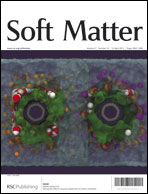Well-defined orthogonal surface wrinkles directed by the wrinkled boundary†
Abstract
In this report, we systematically investigate the as-formed wrinkles to act as a novel boundary to direct the surface wrinkling for controllable fabrication of hierarchical wrinkling patterns. Here the wrinkled boundary is the highly aligned wrinkling patterns, formed in the O2 plasma-exposed region (denoted as D1) when a uniaxially strained polydimethylsiloxane (PDMS) is subjected to the first selective O2 plasma treatment (OPT) via a copper grid. Subsequently, a stiff crust with the tunable composition is fabricated on the whole PDMS including the O2 plasma-unexposed region (denoted as D2), by means of the second OPT and/or additional film deposition (e.g., polystyrene and Pt). The subsequent


 Please wait while we load your content...
Please wait while we load your content...